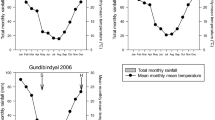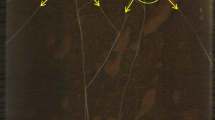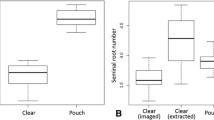Abstract
Suboptimal phosphorus availability is a primary constraint for terrestrial plant growth. Seminal roots play an important role in acquisition of nutrients by plant seedlings. The length and number of seminal roots may be particularly important in acquisition of immobile nutrients such as phosphorus by increasing soil exploration. The objective of this study was to identify quantitative trait loci (QTL) controlling seminal root growth in response to phosphorus stress in maize, and to characterize epistatic interactions among QTL. Seminal root length and number were evaluated in 162 recombinant inbred lines derived from a cross between B73 and Mo17 in seedlings grown in a controlled environment. B73 and Mo17 significantly differed for seminal root length under low phosphorus, but not under adequate phosphorus conditions. Seminal root length of the population grown under low phosphorus ranged from 0 to 79.2 cm with a mean of 32.3 cm; while seminal root length of plants grown under high phosphorus ranged from 0.67 to 59.0 cm with a mean of 23.4 cm. Under low phosphorus, one main-effect QTL was associated with seminal root length and three QTL with seminal root number; under high phosphorus, two QTL with seminal root length and three QTL for seminal root number. These accounted for 11, 25.4, 22.8, and 24.1% of the phenotypic variations for seminal root length and number at low phosphorus, and seminal root length and number at high phosphorus, respectively. Di-genic epistatic loci were detected for seminal root length at low phosphorus (two pairs) seminal root number at low phosphorus (eight pairs), seminal root length at high phosphorus (four pairs), and seminal root number at high phosphorus (two pairs), which accounted for 23.2, 50.6, 32.2, and 20.3% of the total variations, respectively. Seminal root traits observed here were positively yet weakly correlated with shoot biomass in the field under low phosphorus, although no coincident QTL were detected. These results suggest that epistatic interactions are important in controlling genotypic variation associated with seedling seminal root traits.





Similar content being viewed by others
References
Anonymous (1887) Report of the Pennsylvania State College Agricultural Experimental Station. Official Document Number 13
Bauman LF (1959) Evidence of non-allelic gene interaction in determining yield, ear height, and kernel row number in corn. Agron J 51:531–534
Chi KR, Eberhart SA, Penny LH (1969) Covariances among relatives in a maize variety. Genetics 63:511–520
Clark RB, Brown JC 1974 Differential phosphorus uptake by phosphorus-stressed corn inbreds. Crop Sci 14:505–508
Darrah LL, Hallauer AR (1972) Genetic effects estimated from generation means in four diallel sets of maize inbreds. Crop Sci 12:615–621
Da Silva AE, Gabelman WH (1993) Screening maize inbred lines for tolerance to low-P stress conditions. In: Randall PJ (ed) Genetic aspects of plant mineral nutrition. Kluwer, The Netherlands, pp 233–239
Doebley J, Stec A, Gustus C (1995) Teosinte branched 1 and the origin of maize: evidence for epistasis and the evolution of dominance. Genetics 141:333–346
Eberhart SA, Moll RH, Robinson HF, Cockerham CC (1966) Epistatic and other genetic variances in two varieties of maize. Crop Sci 6:275–280
Edwards MD, Stuber CW, Wendel JF (1987) Molecular-marker-facilitated investigations of quantitative-trait loci in maize. I. Numbers, genomic distribution and types of gene action. Genetics 116:113–125
Fan M, Zhu J, Richards C, Brown KM, Lynch JP (2003) Physiological roles for aerenchyma in phosphorus-stressed roots. Funct Plant Biol 30:493–506
Feldman L (1994). The Maize Root. In: Freeling M, Walbot V (eds) The Maize Handbook. Springer, Berlin Heidelberg New York, pp 29–37
Gaume A, Machler F, Leon CD, Narro L, Frossard E (2001) Low phosphorus tolerance by maize genotypes: Significance of root growth, and organic acids and acid phosphate root exudation. Plant Soil 228:253–264
Hinze LL, Lamkey KR (2003) Absence of epistasis for grain yield in elite maize hybrids. Crop Sci 43:46–56
Ho MD, McCannon BC, Lynch JP. (2004) Optimization modeling of plant root architecture for water and phosphorus acquisition. J Theor Biol 226:331–340
Ho MD, Rosas JC, Brown KM, Lynch JP (2005) Root architectural tradeoffs for water and phosphorus acquisition. Funct Plant Biol 32:737–748
Hund A, Fracheboud Y, Soldati A, Frascaroli E, Salvi S, Stamp P (2004) QTL controlling root and shoot traits of maize seedlings under cold stress. Theor Appl Genet 109:618–629
Jinks JL (1955) A survey of the genetic basis of heterosis in a variety of diallel crosses. Heredity 9:223–238
Kaeppler SM, Parke JL, Mueller SM, Senior L, Stuber C, Tracy WF (2000) Variation among maize inbred lines and detection of quantitative trait loci for growth at low phosphorus and responsiveness to arbuscular mycorrhizal fungi. Crop Sci 40:358–364
Lamkey KR, Schnicker BS, Melchiger AE (1995) Epistasis in an elite maize hybrid and choice of generation for inbred line development. Crop Sci 35:1272–1281
Liao H, Rubio G, Yan X, Cao A, Brown K, Lynch JP (2001) Effect of phosphorus availability on basal root shallowness in common bean. Plant Soil 232:69–79
Lynch JP, Epstein E, Lauchli A, Weigt GE (1990) An automated greenhouse sand culture system suitable for studies of P nutrition. Plant Cell Environ 13:547–554
Lynch JP (1998) The role of nutrient efficient crops in modern agriculture. J Crop Production 1:241–264
Lynch JP, Brown KM (2001) Topsoil foraging—an architectural adaptation to low phosphorus availability. Plant Soil 237:225–237
Lynch JP, Deikman J (1998) Phosphorus in plant biology: regulatory roles in molecular, cellular, organismic, and ecosystem processes. Curr Topics Plant Physiol: An American Society of Plant Physiologists Series, vol 19. Rockville, Maryland, USA, pp 1–401
Lynch JP, van Beem JJ (1993) Growth and architecture of seedling roots of common bean genotypes. Crop Sci 33:1253–1257
Ma Z, Walk TC, Marcus A, Lynch JP (2001) Morphological synergism in root hair length, density, initiation and geometry for phosphorus acquisition in Arabidopsis thaliana: a modeling approach. Plant Soil 236:221–235
Miller CR, Ochoa I, Nielsen KL, Beck D, Lynch JP (2003) Genetic variation for adventitious rooting in response to low phosphorus availability: potential utility for phosphorus acquisition from stratified soils. Funct Plant Biol 30:973–85
McMullen MD, Snook M, Lee EA, Byrne PF, Kross H, Musket TA, Houchins K, Coe Jr. EH (2001) The biological basis of epistasis between quantitative trait loci for flavone and 3-deoxyanthocyanin synthesis in maize. Genome 44:667–676
Naismith RW, Johnson MW, Thomas WI (1974) Genetic control of relative calcium, phosphorus, and manganese accumulation on chromosome 9 in maize. Crop Sci 14:845–849
Nielsen NE, Barber SA 1978 Differences among genotypes of corn in the kinetics of P uptake. Agron J 70:695–698
Rubio G, Liao H, Yan X, Lynch JP (2003) Topsoil foraging and its role in plant competitiveness for phosphorus in common bean. Crop Sci 43:598–607
Rundel PW, Nobel PS (1991) Structure and function in desert root systems. In: Atkinson D (eds) Plant root growth: an ecological perspective, Special Publication Number 10 of the British Ecological Society. Blackwell, Oxford, UK, pp 349–378
Senior ML, Chin ECL, Lee M, Smith JSC, Stuber CW (1996) Simple sequence repeat markers developed from maize sequences found in the GENEBANK database: Map construction. Crop Sci 36:1676–1683
Silva JC, Hallauer AR (1975) Estimation of epistatic variances in Iowa stiff stalk synthetic maize. J Hered 66:290–296
Tuberosa R, Sanguineti MC, Landi P, Giuliani MM, Salvi S, Conti S (2002) Identification of QTL for root characteristics in maize grown in hydroponics and analysis of their overlap with QTL for grain yield in the field at two water regimes. Plant Mol Biol 48:697–712
Tuberosa R, Salvi S, Sanguineti MC, Maccaferri M, Giuliani S, Landi P (2003) Searching for quantitative trait loci controlling root traits in maize: a critical appraisal. Plant Soil 255:35–54
Wang DL, Zhu J, Li ZK, Paterson AH (1999) Mapping QTL with epistatic effects and QTL x environment interactions by mixed linear model approaches. Theor Appl Genet 99:1255–1264
Wolf DP, Hallauer AR (1997) Triple testcross analysis to detect epistasis in maize. Crop Sci 37:763–770
Xiao J, Li J, Yuan L, Tanksley SD (1995) Dominance is the major genetic basis of heterosis in rice as revealed by QTL analysis using molecular markers. Genetics 140:745–754
Zhu J (1998) Mixed-model approaches of mapping genes for complex quantitative traits. In: Wang LZ, Dai JR (eds) Proc genet and crop breed of China. Chinese Agricultural Science and Technology Publication House, Beijing, pp 19–20
Zhu J (2003) Composite interval mapping and physiological function of root traits conferring phosphorus efficiency in maize (Zea mays L.). PhD thesis, the Pennsylvania State University, University Park, USA, pp 1–150
Zhu J, Lynch JP (2004) The contribution of lateral rooting to phosphorus acquisition efficiency in maize (Zea mays L.) seedlings. Funct Plant Biol 10:949–958
Zhu J, Weir BS (1998) Mixed-model approaches for genetic analysis of quantitative traits. In: Chen LS, Ruan SG, Zhu J (eds) Advanced topics in biomathematics. Proceedings of the international conference on mathematical biol. World Scientific, Singapore, pp 321–330
Zhu J, Kaeppler SM, Lynch JP (2005a) Topsoil foraging and phosphorus acquisition efficiency in maize (Zea mays L.). Funct Plant Biol 32:749–762
Zhu J, Kaeppler SM, Lynch JP (2005b) Mapping of QTL for lateral root branching and length in maize (Zea mays L.) under differential phosphorus supply. Theor Appl Genet 111:688–695
Zhu J, Kaeppler SM, Lynch JP (2005c) Mapping of QTL controlling root hair length in maize (Zea mays L.) under phosphorus deficiency. Plant Soil 270:299–310
Zobel R (1996) Genetic control of root systems. In: Waisel Y, Eshel A, Kafkafi U (eds) Plant roots: the hidden half, 2nd edn. Marcel Dekker, New York, pp 21–30
Acknowledgements
We thank Dr. Richard Craig for helpful discussion in experimental design and statistical analysis. This research was supported by USDA-NRI grant 00353009246 to Shawn M. Kaeppler and Jonathan P. Lynch
Author information
Authors and Affiliations
Corresponding author
Additional information
Communicated by D.A. Hoisington
Rights and permissions
About this article
Cite this article
Zhu, J., Mickelson, S.M., Kaeppler, S.M. et al. Detection of quantitative trait loci for seminal root traits in maize (Zea mays L.) seedlings grown under differential phosphorus levels. Theor Appl Genet 113, 1–10 (2006). https://doi.org/10.1007/s00122-006-0260-z
Received:
Accepted:
Published:
Issue Date:
DOI: https://doi.org/10.1007/s00122-006-0260-z




